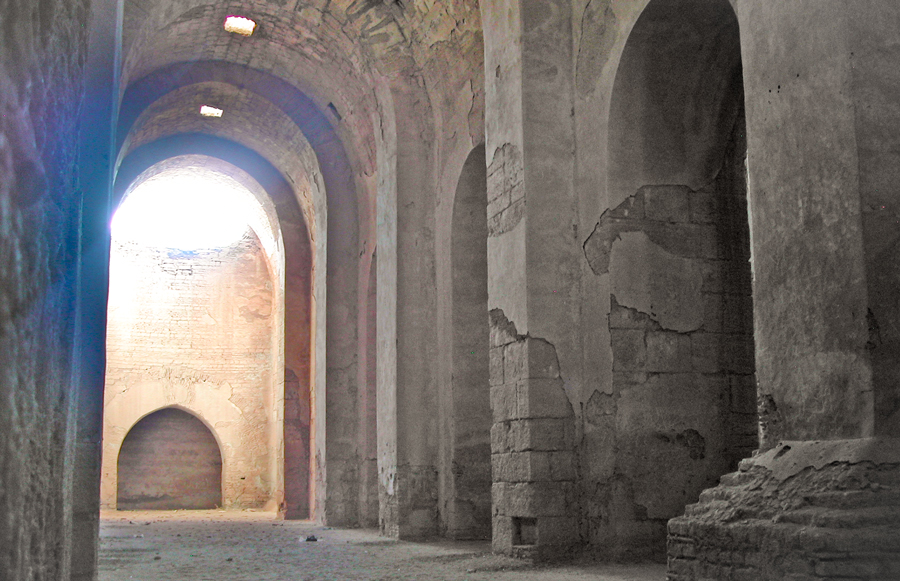Focus of this project was on questions concerning the water-management and the historic land-use of the archaeological site Resafa in North-Syria.
Research

Resafa, Syria. Great cistern, view to the east | M. Gussone 2006
Resafa-Sergiupolis, set in an inhospitable region at the site of a limes fort, 25 km south of the Euphrates arose in the period between the mid 5th and very early the 6th century AD. Environmental conditions in the Resafa area made it a poor choice as the site of a large city. Although it became an important pilgrimage site and attracted huge crowds of first Christian, and later Muslim pilgrims. The impression of monumentality is underlined by Resafa’s position on the crest of the bank of a wadi, which runs along a tectonic fault line. In addition to the city wall and the five large churches in the city that were certainly perceived to be ‘large-scale construction projects’ at the time of their construction, the city’s complement of monumental structures included four large cisterns, which have been characterized as ‘masterpieces of late Roman engineering’.
Written sources contain only relatively brief descriptions of the buildings in Resafa. It is therefore noteworthy that the city’s water supply system is mentioned regularly, which is probably explained by Resafa’s position “in a desert without water”. These sources generally identify the rulers as being the initiators or as responsible for the water supply system construction projects, which underlines the significance and representative nature of these infrastructure projects.
The fact that the water supply system does not consist only of large cisterns in the city, but also incorporates the surrounding area testifies to the large spatial scale of the projects as well.
Results
The results concerning the water supply of Resafa were achieved, in a multi disciplinary research project, consisting of archaeologists, architects/buildings archaeologists, geodists and physical geographers. In the surroundings the historic landscape was reconstructed by an investigation of soil conditions and the amount of precipitation as well as the water harvesting methods to collect the runoff of the rainfall during the winter months. The gardens of a palace and water engineering facilities supplying the city were archaeologically examined. Additionally a digital terrain model was created by geodetic surveys, with computer simulations the seasonal rainfall runoff and its collection was verified. The Great Cistern in the city had been documented by terrestrial laser scanning shortly before the outbreak of the war in Syria. The structural analysis of this data provided new findings about the construction process as well as several reconstruction and repair phases of the Great Cistern. This was supplemented by an analysis of written sources, which provided new insights into the interrelationship of local elites (in this case mainly the clergy of the pilgrimage town) in Late Antiquity, who were responsible for the construction of infrastructure systems.
The monumentality of the city of Resafa and its water supply system arises from the combination of the system’s specific, quantitative size and city’s remote location. The amount of work invested in building the system and maintaining its monumental cisterns was great enough to justify the assumption that central planning and higher-level organizational structures had been involved. The cisterns were maintained and kept in repair as long as the city was inhabited. This indicates a continuing transfer of engineering knowledge and construction experience uninterrupted by multiple changes in the system of rule, and testifies to the vital importance of the water supply for the pilgrimage city and caliphal residence in the semi-arid desert steppe.
Research results have been presented in various publications e.g.
Hagan Brunke, Evelyne Bukowiecki, Eva Cancik-Kirschbaum, Ricardo Eichmann, Margarete van Ess, Anton Gass, Martin Gussone, Sebastian Hageneuer, Svend Hansen, Werner Kogge, Jens May, Hermann Parzinger, Olof Pedersén, Dorothée Sack, Franz Schopper, Ulrike Wulf-Rheidt and Hauke Ziemssen, “Thinking Big. Research in Monumental Constructions in Antiquity”, in: Space and Knowledge. Topoi Research Group Articles, eTopoi. Journal for Ancient Studies, Special Volume 6 (2016), 250–305
Catharine Hof, “Late Antique vaults in the cisterns of Resafa with ‘bricks set in squares’”, in: Ine Wouters, Stephanie van de Voorde, Inge Bertels, Bernard Espion, Krista de Jonge and Denis Zastavni (Eds.), Building Knowledge, Constructing Histories, Volume 2. Proceedings of the 6th International Congress on Construction History (6ICCH 2018), July 9-13, 2018, Brussels, Belgium , London: CRC Press, 2018, 755–763
Catharine Hof, “Werkgruppe und Pensum – Zur Baustellenorganisation an der Stadtmauer von Resafa”, in: Klaus Rheidt and Werner Lorenz (Eds.), Groß Bauen. Großbaustellen als kulturgeschichtliches Phänomen, Berlin, Boston: De Gruyter, 2017, 63–76
Catharine Hof, “The monumental Late Antique cisterns of Resafa, Syria as refined capacity and water-quality regulation system”, in: Federico Buccellati, Sebastian Hageneuer, Sylvia van der Heyden and Felix Levenson (Eds.), Size Matters – Understanding Monumentality Across Ancient Civilizations, Bielefeld: transcript, [inpress]
Dorothée Sack, “Kalifenresidenz und Pilgerort – zur Sakralität von Resafa in umaiyadischer Zeit”, in: Manfred Luchterhand and Hedwig Röckelein (Eds.), Palatium Sacrum. Sakralität am Hof des Mittelalter – Orte, Objekte, Rituale, 2019
Related links
- Research project Topoi I (2007 – 2012): Resafa – Rusafat Hisham. The residence of Caliph Hisham b. Abd al-Malik (rgn. 724 – 743 AD)
- Deutsches Archäologisches Institut: www.dainst.org/projekt/-/project-display/52384
- Technische Universität Berlin: http://bauforschung-denkmalpflege.de/resafa/
